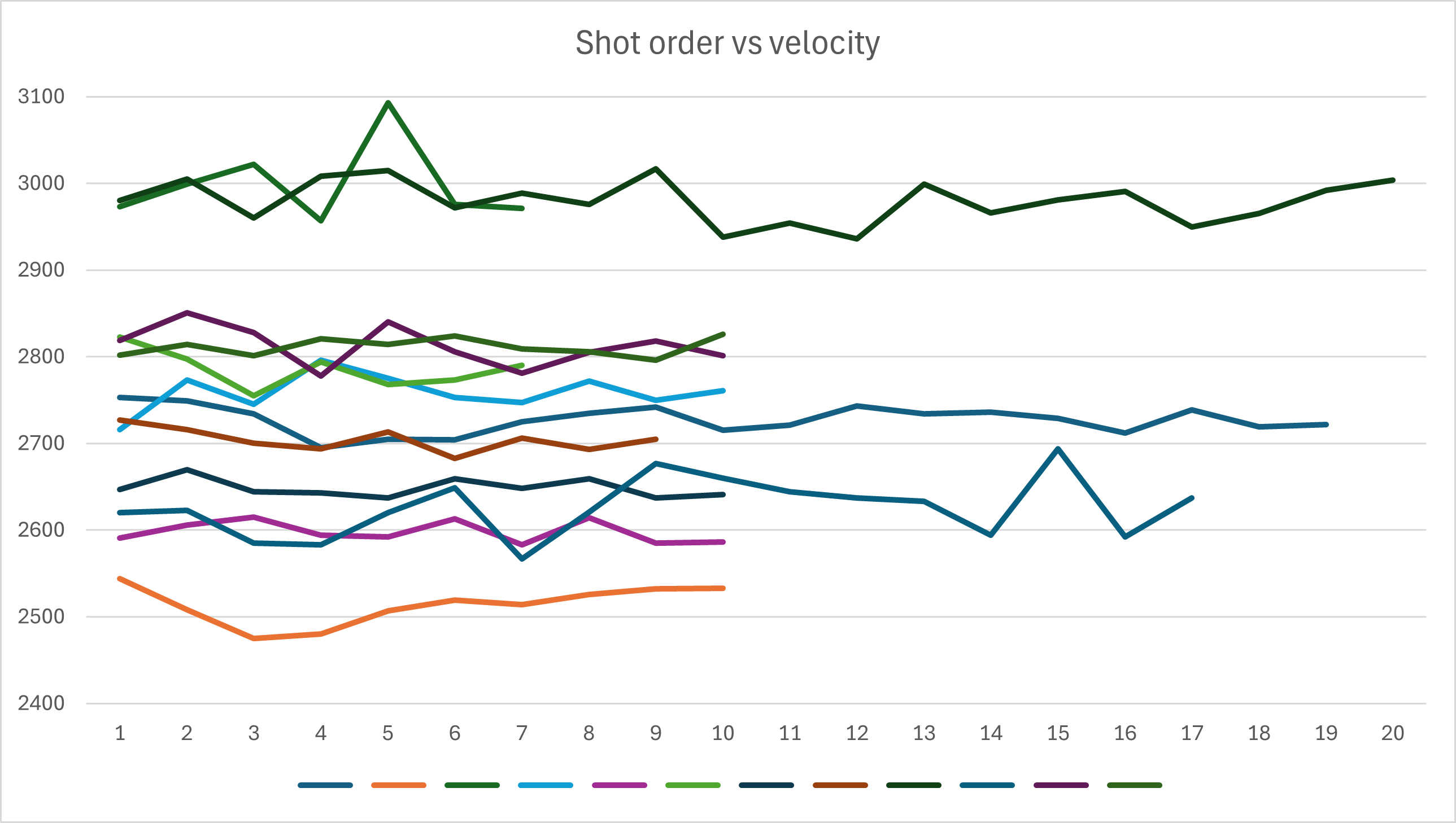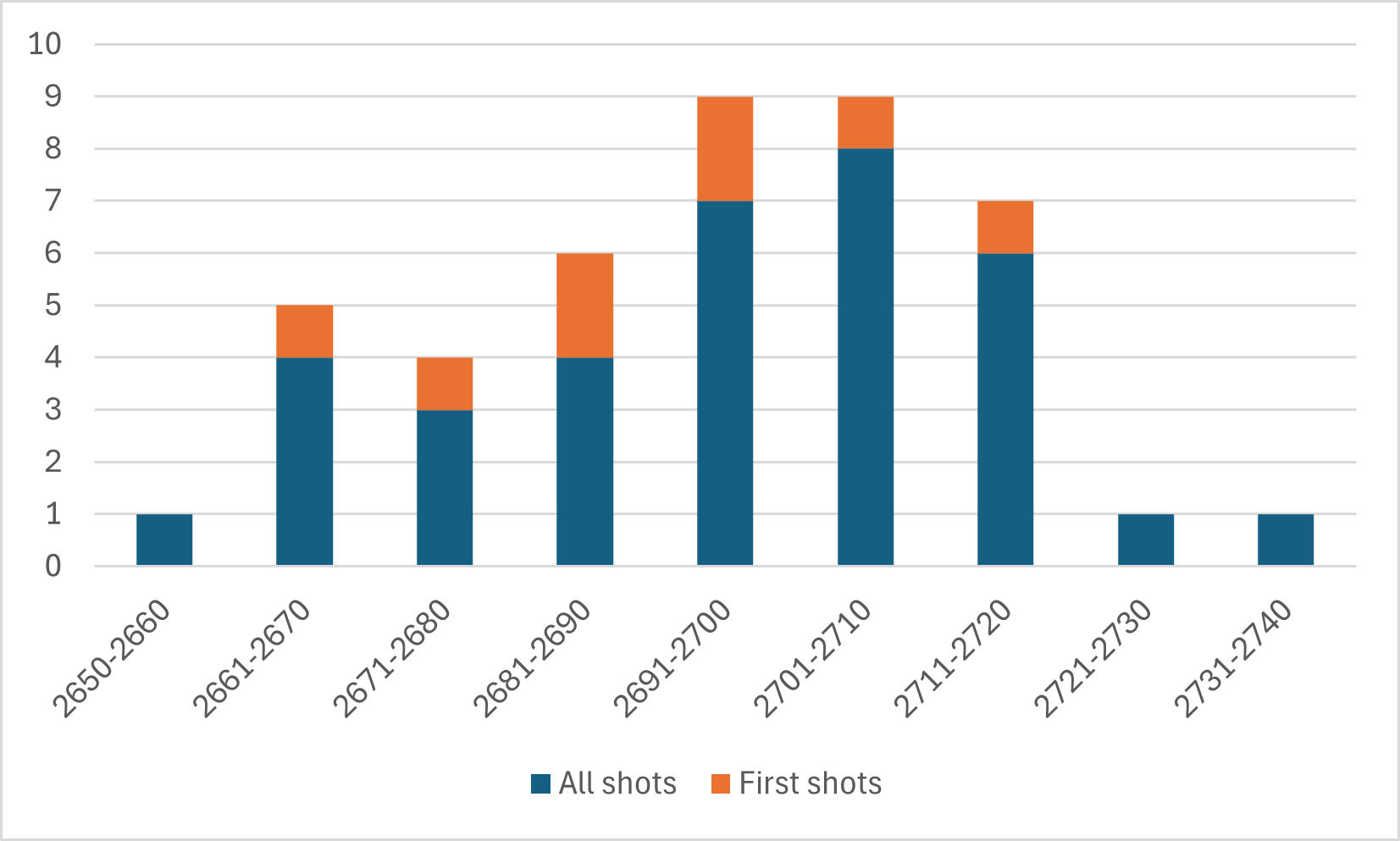Welcome guest, is this your first visit? Create Account now to join.
Welcome to the NZ Hunting and Shooting Forums.
Search Forums
User Tag List
+ Reply to Thread
Results 16 to 30 of 42
-
04-08-2024, 01:45 PM #16
-
-
04-08-2024, 02:21 PM #17
Yeah, or your specific rifle - be interesting to see the data. I'll graph up some
-
04-08-2024, 10:59 PM #18Member

- Join Date
- Jul 2014
- Location
- BOP
- Posts
- 4,081
I have noticed the velocity increases after the first shot on a cold clean bore, it seems to increase over the next two to three shots then it settles down. The spread in velocity from the first shot to the last (3shots) is around 30-40 fps. I read that the carbon left in the barrel helps increase the velocity to a degree. Over normal shooting ranges it should alter points of impact to much.
-
05-08-2024, 02:41 PM #19
Here you go I managed to find some data from a range day on April 2024. All shot strings were starting with a cold, clean barrel. Velocity recorded with a Labradar.
Sauer 100 6.5CM 13gn Sierra TGK 43gn 2209: 2730, 2756, 2753,2780, 2775
Tikka T3x 6.5CM Hornady Superformance 129 SST factory load: 2731, 2777, 2755, 2751, 2766, 2765.
Tikka T3x .223 73gn ELDM 25gn 2208: 2731, 2777, 2755, 2751, 2766, 2765ZeroPak Vacuum Sealers, Zero air Zero waste
-
05-08-2024, 03:21 PM #20
Interesting that you have that trend.
I plotted 12 different strings of shots from various different rifles, from 7-20 shots (why 12? I got sick of typing)
in 1 of 12 series, the first shot was the lowest.
You can see visually that across these rifles, ammo and shot strings there is no tendency for the (cold) first shot to be outside the normal shot-to-shot variation.
I never clean back to bare metal but some of these would be "clean-er" cold bore

-
05-08-2024, 03:29 PM #21Member

- Join Date
- Jan 2021
- Location
- Te Awamutu
- Posts
- 136
-
05-08-2024, 05:32 PM #22Member

- Join Date
- Sep 2022
- Location
- Carterton
- Posts
- 611
Last edited by Eat Meater; 05-08-2024 at 05:33 PM. Reason: Typos
-
05-08-2024, 05:34 PM #23
A mix. 4 or 5 different rifles and different loads through each. Handloads and factory
-
05-08-2024, 05:39 PM #24Member

- Join Date
- Sep 2022
- Location
- Carterton
- Posts
- 611
8 of the 12 had a lower or the same velocity compared with the second shot.
Please update chart with another 18 strings so we can evaluate properly
Identify your target beyond all doubt because you never miss (right?) and I'll be missed.
-
05-08-2024, 09:01 PM #25Member

- Join Date
- Jul 2015
- Location
- Christchurch
- Posts
- 1,476


-
05-08-2024, 10:31 PM #26Member

- Join Date
- Jul 2012
- Location
- Invervegas
- Posts
- 5,664
-
06-08-2024, 12:59 AM #27Member

- Join Date
- May 2012
- Location
- Sydney
- Posts
- 1,817
Mistake in the data. Last two strings are the same.
Sent from my iPhone using Tapatalk
-
06-08-2024, 08:51 AM #28
-
06-08-2024, 10:44 AM #29
I think it's useful to be clear on the hypothesis we are trying to test. To my interpretation it is "that the velocity of the first shot from a cold bore is meaningfully and consistently different from the mean velocity and spread". Note this is cold, not cold "clean", because I don't see any good reason to ever clean down to bare metal. A couple of patches occasionally is still "fouled".
If it isn't meaningfully and consistently different, any trend is immaterial, but it would be nice to know if it is - if that's actionable.
What would consistent and meaningful look like?
To allow us to take an action to control for any effect and realise a benefit, it would need to be consistent enough in a particular direction to avoid over-correcting in the other direction with any frequency, and consistent enough in magnitude to act on.
A meaningful difference in magnitude would by definition have to be "something outside the normal expected distribution of shot velocities", as that is the default solution - use the mean velocity and form expectations for hit probability based on standard deviation (although this is only very infrequently the most significant factor).
We shouldn't have an inherent position on what the answer is, but we should be trying to use available data to test this question and find the right answer. Practically speaking, to confidently identify that something is different from the rest of the population requires a lot of data, and it takes a lot less data to identify that there isn't a meaningful difference.
My initial scan of data available to me suggests there is not a difference, but I would like to know if that's not the case. I might miss less things.
So what data do I have to test this? A scan across multiple rifles and loads (5x .223s, a 6mm223, a 6.5G, a 6.5CM, a .260, and a .308) indicates that the majority of the first shots fall within the normal distribution for that rifle.
You would expect, particularly on shorter shot strings, that sometimes the first shot will be the lowest velocity. In a 3 shot group you have a 1 in 3 probability of that. A larger dataset will provide a better picture of your overall velocity distribution. You would also expect that the 2nd velocity will be higher than the first, around 50% of the time. The other 50% or so, it will be lower. Sometimes, depending on how consistent your velocities are, it will be the same. This is sort of immaterial unless the trend is extremely consistent in one direction and allows us to take some sort of corrective action, and of a sufficient magnitude that we'd realise a benefit from taking that action. Looking at that trend isn't terribly useful. Across 15 shot strings I looked at, 5 of the first shots were a higher velocity than the next, and 10 were lower - however that isn't really sufficiently different from 50/50 to make any statement - what we can say is that with different rifles and loads the direction isn't consistent enough to be actionable even if it was real.
What about with one rifle and one load? I have 39 shots of chrono data across 8 strings (some 1 shot) with the same rifle and load with a cold bore.
This is what the distribution of these shots, and the first shots from each string, looks like.

The velocity distribution is tending towards a normal distribution. The mean is 2695 with an SD of 19. There isn't sufficient data to form a better picture. You might infer that there is some skewness in velocities generally below the mean, and the first shot distribution isn't showing any tendency to be different to the overall shot distribution. None of the first shots are outside the overall range, or would produce a different result than I would expect based on hit probability calculated with my velocity mean and standard deviation.
I'll add more data as I collect it but at this stage, I don't see any evidence for a meaningful trend across multiple rifles or this specific rifle and load.
This is insanely irrelevant to the average hunter - even if your first shot were consistently 50fps slower than your mean velocity, you might expect a 4cm difference in drop at 400 metres.
-
06-08-2024, 11:18 AM #30
I don’t know anything about first shot velocity difference because I’ve never recorded it .
But I would like to comment in regards to any first shot POI shift .
I was listening to podcast a while ago where the very experienced shooter mentioned that he believes that any cold bore POI shift is more to do with a “ Cold shooter “ rather than a “ Cold bore “ .
He suggested that the shooter should “ dry fire “ a few times before sending that first round down range.
I’ve done this ever since , and it’s surprising how many times I’ve adjusted my natural point of aim / position before shooting that first shot .
I can honestly say that since doing this I’ve noticed very little to no POI shift from my first shot to the subsequent following shots of the group .
When I have a shot fall outside of the group no matter which shot it was in the group, the first thing I question is myself and not the load .
Sure there are times when that flyer is unexplained, but the majority of the time it had something to do with my shooting form / setup.FALL IN LOVE WITH THE NUMBERS , NOT THE IDEA
Similar Threads
-
Cold Bore First Shot
By McNotty in forum ShootingReplies: 42Last Post: 02-01-2024, 12:15 PM -
3 vs 5 shot groups
By Magnetite in forum Reloading and BallisticsReplies: 31Last Post: 23-04-2022, 03:12 PM -
Is it 'Cold Bore' or 'Foul Bore' ?
By redbang in forum ShootingReplies: 31Last Post: 17-01-2021, 08:42 PM -
3 Shot Cold Bore Group to 375yrds
By Lucky in forum ShootingReplies: 18Last Post: 24-09-2019, 03:16 PM -
cold/clean bore shot
By mawzer308 in forum ShootingReplies: 16Last Post: 05-02-2016, 08:31 PM
Tags for this Thread
Welcome to NZ Hunting and Shooting Forums! We see you're new here, or arn't logged in. Create an account, and Login for full access including our FREE BUY and SELL section Register NOW!!





 58Likes
58Likes LinkBack URL
LinkBack URL About LinkBacks
About LinkBacks




 Reply With Quote
Reply With Quote


Bookmarks